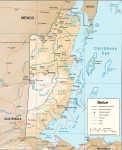
 |
| Route Map |
Since I had been down in December to work on Malakii , it was pretty easy to go sailing this year. I left Montana in mid February in a snowstorm. It snowed off and on all the way down to Denver, where I got on a plane and flew to Guatemala City. From there I took a bus to the Rio, and a launch down the Rio 15 miles to Bahia de Buena Vista, a.k.a. Gringo Bay, where Malakii was moored.
 |
| Leaving Montana |
Gringo Bay is one of the more peaceful places I've ever spent an extended amount of time. Malakii was in good shape. I hung up the valentine Adin, my next door neighbor, gave me before I left. In a few days I had things ready to go. I sailed up to Fronteras, a.k.a. Rio Dulce, bought supplies, and returned to Gringo Bay.
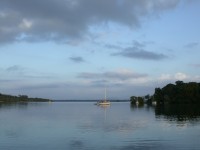 |
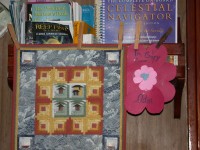 |
| Gringo Bay | Adin's Valentine |
The next morning I headed down the river to Livingston, where I checked out. By the time I was done checking out, it was 3:00 pm. Livingston is a gawd-awful place to spend the night on a boat, as the river flows out and the wind almost always blows in. You get steep choppy waves and the wind opposing the current, making the boat wander around on her anchor as the wind and the tide changes. I decided I had done that enough, so I weighed anchor and headed out. I knew I couldn't reach any anchorage before dark, but I also was pretty sure it would be nice and calm in the lee of Cabo Tres Puntas, a peninsula to the northeast of Livingston. I was about half way to Cabo Tres Puntas as the sun went down. We continued on in the dark. I could see the outline of the cape, a low finger of land, but as it got blacker and blacker it became harder and harder to differentiate land from water. We crossed Ox Tongue shoal, where it was 12-20 feet deep, and then it was 60 - 90 feet. It was too dark to safely get into the bay I had hoped to reach, as I didn't have reliable GPS waypoints for it. So I decided to sneak up on the cape a bit further out. I checked the chart and discovered that at the end of the cape it stayed deep until pretty close to shore. When we got a few miles from the tip of the cape, I dropped the jib and slowly worked towards shore, watching the depth sounder. Once we got into shallow water for a ways, I dropped the hook. It was a very peaceful night, an order of magnitude better than rocking and rolling in Livingston.
 |
| Livingston Sunset |
The next morning I headed for Belize. The wind was blowing pretty good from the Northeast, so we were beating all of the way. I decided to check in at Placencia instead of Punta Gorda, as with this wind Punta Gorda would be as bad as Livingston was. My autopilot wasn't working, but for once I was able to balance the sails so I didn't have to tend the helm most of the time. In the photo below labeled "Bow splash," the yellow and red lines are the safety lines, known as "jacklines," I clip my harness into to keep me attached to the boat if I go crazy and try to jump overboard, or if a wave hits me or I slip. They're flat nylon webbing, so they won't roll and cause you to lose your balance if you step on them.
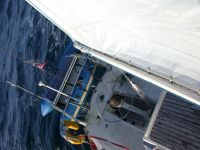 |
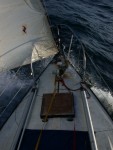 |
 |
| Looking aft, no autopilot | Bow splash | Heading North |
I couldn't make it to Placencia in one day, so I headed for Tom Owens Cay. I got there about 4:00 pm, barely in time because of the light needed to make it through the coral. Tom Owens is a pair of cays. The east one was pretty much destroyed in the recent hurricanes. The west one was recently bought by a guy who is hoping to turn it into an eco resort. I'm not sure how successful he'll be, but the concrete / shell urt-like dwellings his hired man is building were interesting. They have roofs shaped like chinese hats which are rigged to collect water, and a raised sleeping platform with water storage underneath. The windows are odd shaped pieces of glass from the owner's power boat, which was destroyed in the hurricanes as well.
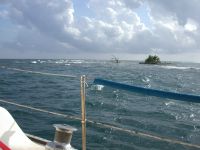 |
 |
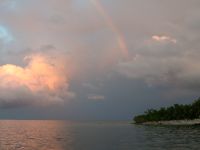 |
| Tom Owens East | Tom Owens West | Rainbow |
I took a layover day the next day, patched a tear in the mainsail, and tried to fix the autopilot. I thought I had it fixed, but when I headed to Placencia the next day, it refused to work. I sailed out from Tom Owens and got about a mile away, and then the wind totally died. I spend the next three hours going no where. When the wind finally started to do something, it wasn't clear whether I would make it to Placencia before dark or not. I couldn't get the sails balanced for any significant period of time, so I had to mind the helm most of the way, and couldn't get anything else done. My plan was to sail to Big Creek and anchor there for the night so I could check in first thing in the morning. Unfortunately, because of the fickle wind I got to the buoys marking the channel at dark, and couldn't see well enough to follow them in. I decided discretion was the better part of valor, and sailed up towards Placencia and anchored just south of the harbour.
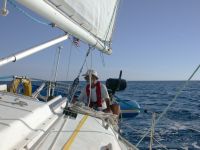 |
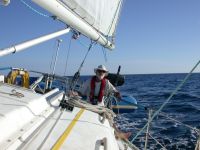 |
| Still no auto pilot |
It took a whole day to get checked in, as the immigration man was out at the airport all morning and didn't show up to his office until about 2:00pm. I went up to Placencia, bought supplies, and spent the night. The next day I sailed up to where my friends Kathy and Travis, neighbors from Ovando, were renting a cottage. The weather was reasonably calm, so I anchored in front of their cottage and we went out to dinner and did some catching up.
Travis and Kathy wanted to go for a sail, but had a prior arrangement for some sight-seeing in the morning. I hung out and did some chores on the boat, then took them for a sail in the afternoon.
 |
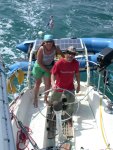 |
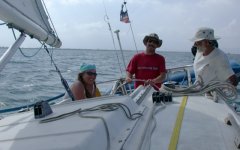 |
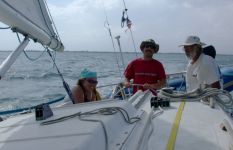 |
| Kathy and Travis | Kathy, Travis and Gary |
I had about ten days before I had to meet my brother in Belize City, so I headed out to explore some cays near Gladden Spit which I had not seen. The first of these was North Long Cocoa. I got there in good time, dropped the hook, put up my jury-rigged sun awning, rigged the rain catcher some friends had given me last year so I could try it out, and chilled out.
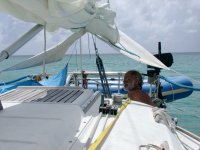 |
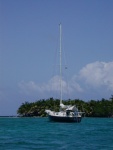 |
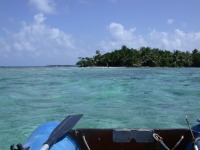 |
| At North Long Cocoa | Malakii at... | North end North Long Cocoa |
Then I took the dink over to the island to explore. The north end has a small beach, where I found a few baby coconuts just coming up. I transplanted them to places where they might do a little better and help hold the cay together.
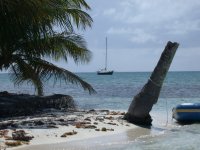 |
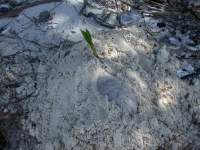 |
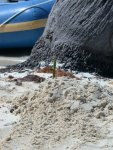 |
| Malakii from N Long Cocoa beach | Baby coconut |
There were a lot of pelicans around, and no wonder... Most of the water on the lee side of the island is pretty shallow, with the bottom covered in grass. The shallows are occupied by thousands of small fish, as well as starfish and other critters.
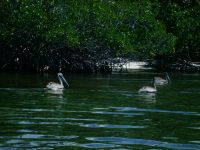 |
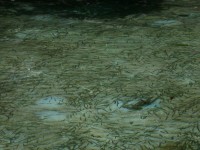 |
 |
| Pelicans | Nursery | Starfish |
The south end of the island has a fish camp. Like most fish camps, it's a run-down shed with a table and a few makeshift chairs, and discarded junk lying around.
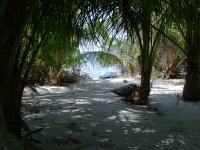 |
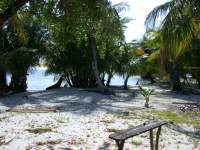 |
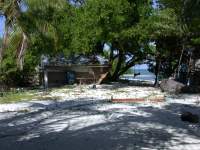 |
|
| Under the palms | Fish camp |
Rendezvous Cay is just a short distance away. It is supposed to have an reasonable anchorage on both sides, but I didn't check either one of them out. There are two Rendezvous Cays in Belize; this is the southern most one.
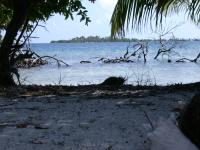 |
| Looking to Rendezvous Cay |
As I was getting ready to go snorkling, two catamarans showed up and anchored nearby. There are two charter companies in Placencia, and they send a lot of boats out, so you're likely to run into them fairly often if you're within the normal one week cruising circle. I took my spear gun and hopped in the dink and went over to the windward side of the island, hoping to spear a fish for dinner. I managed to spear a nice one, but my aim was off and the spear stuck just behind his dorsal fin. He swam off, and as he did, the line attaching the spear to the speargun parted. I swam after him, hoping he would hide or I could catch him and grab the string, but the visibility wasn't very good and he disappeared. I was bummed, as I didn't have another spear, although I did have my Hawaiian Sling. I went back to the boat, got the Hawaiian Sling, and went out. I didn't get close enough to anything big enough to spear for dinner, and I didn't find my spear. Waaaah! Another lesson learned -- replace the line on the spear every season. I felt bad about shooting and most likely killing something I wasn't going to be able to eat. Unlike on land, there's no trail you can follow to find a wounded fish, especially in this terrain of mostly sea grass with few places to hide and low visibility. However, I doubt if it was wasted; in this fish eat fish world, everything is devoured by something higher up the food chain.
When I bought fresh produce in Placencia, the woman in the market had some strange looking thing I'd never seen before. It looked like a cross between a pear and a kohlrabi. I asked what it was, and another woman said it was good for the heat. I asked how you prepared it, and she said you could eat it raw, fry it, do whatever you want. "It's good for the heat." So I bought one. It kept well, and I finally peeled it and ate some of it raw, and stir fryed the rest. It was pretty good, although rather bland. Kind of like a kohlrabi.
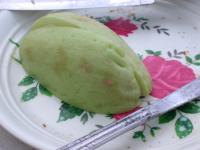 |
 |
| Strange food |
The next day I moved a few miles northeast, over to Jack's Cay. It isn't as good an anchorage, but the weather was easing up a bit and I liked it because the charter boats didn't seem to go there.
 |
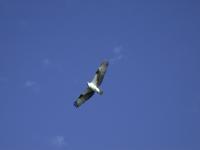 |
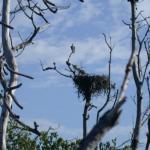 |
| Osprey at Jack's Cay | Osprey Nest and Young'uns |
On the lee side of Jack's Cay there is a small deep spot surrounded by a ridge of mostly sea grass. When I arrived I wasn't sure how to get into it, as there is a relatively narrow slot where the water is a little deeper and it is supposed to have at least six feet clearance. After I was anchored, I snorkled around it, then took the dink and checked the depth. There was a spot to get in, but there wasn't much swinging room inside. I decided I liked where I was. I had the anchor in the sand on an underwater ridge; I dove it to make sure it was well set, and I felt reasonably secure.
I brought my sextant down with me this time, and spent some time practicing taking sights and doing sight reduction and plotting to see where I was. I was generally close to where I was supposed to be, although never as close as I would have liked. I was using an appreviated sight reduction table that used a different method than the one I originally learned, and I am still suspicious of it. I brought home some of my exercizes and will check them against the big tables.
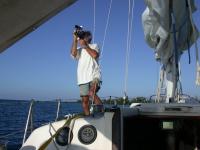 |
| Taking a sight with the sextant |
In the afternoon I took a conch I had picked up and made it into a horn. You cut off the small end, which you then blow into like a bugle. However, the shell has to be otherwise intact, and most conch shells you find have a hole near the end where the conch was cut loose so it could be taken out and eaten. This one was no exception, but I found I could cover the hole with my fingers. My first cut didn't take enough of the end off, and the mouthpiece was too small. Unfortunately, when I tried to enlarge it I mis-judged and cut off too much, and it didn't sound very good. I decided to keep looking for another shell, one without a hole.
 |
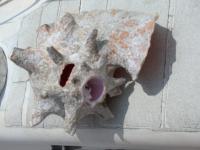 |
| Conch horn |
I took the dink and rowed around the cay, and discovered that the windward side, to the east, has some wonderful coral heads and good snorkling. So just as before the sun was going down I went back over and went snorkling. I found a nice conch and I brought it back to the boat, thinking I could get the conch out without breaking the shell and use it to make a horn.
I kept it overnight, but in the end, it seemed like a waste to kill the conch just to make a horn. So I wished it well and tossed it overboard in what looked like good conce habitat. I headed outside the barrier reef, sailed up to Southwater Cay and then over to Tobacco Range.
Every time I start to feel like I know what I'm doing, something happens to make me eat humble pie. After a pleasant night, I went to sail out of my little spot in Tobacco Range and before I got turned around I was aground. I wasn't as familiar with the little slot I was anchored in as I thought. I had thought I had a little more room before it got shallow, I wasn't quite as quick to get back to the helm after raising the hook, and Malakii just didn't want to come around. It was no big deal, although a bit of an effort to get kedged off. The stern anchor didn't grab very well, which surprised me. It's a small danforth, and the larger danforth on the bow always bites in good in that anchorage. But the stern hook doesn't have much chain on it, and I think it's really too light to be of much use. The whole episode was a personal embarassment, a reminder that every day you start with a clean slate.
I sailed up to Bluefield Range, where I met Dick and Ginger on Alchemy. I asked Dick if he had a full set of sight reduction tables, as I wanted to check one of my sights to see if my abbreviated tables were part of the error I was seeing. I took my sextant over and he got out his and we took some sights, traded sextants, did it again, and compared. We checked three sights, and I was about 2 minutes of arc greater than his reading each time. We checked his sextant for index error and it was 1.8 off the arc, so that accounted for it, as mine has zero index error. We ran one of my sights through his sight reduction calculator and came up with a similar calculated altitude and zenith but the intercepts were significantly different, his yielding a result which more accurately fixed the actual location. It was a whopping 16 minutes different, or about 16 miles. All of this made me want to run the same figures through the full sight reduction tables when I got home.
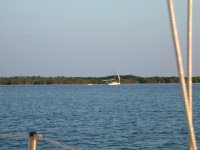 |
| Fishermen at Bluefield Range |
The next day was March 9th. Happy bird egg to me, I'm now officially a year older, again. Blech. I guess I don't mind being a year older as long as I don't feel it. Moses, one of the local fishermen, paddled over to request some matches.
I sailed over to Belize City flying just the main, as the wind was now blowing pretty good out of the SE, right at my back. The seas were up to three or four feet, and without the autopilot and with no jib up, it was pretty close to impossible to leave the helm for very long. I should have put the storm jib up but didn't want to mess with it, assuming I was going into the marina at Cucumber Beach. Unfortunately, I couldn't get into the marina. They were full, probably because it was blowing and predicted to continue for a few days and people were scampering for cover. Unfortonately, there's no reasonable shelter in the Belize City area in SE winds. Since I had to meet Dave at the airport in two days and needed to get supplies and run errands, I had to make do. I ran up the storm jib and flew over to Peter's Bluff, off Moho Cay. I snuggled as close to the mangroves as I could but it wasn't anywhere close to close enough to get out of the wind and waves. At least the holding was good, so I could rock and roll without anxiety. It's an unpleasant spot for anchoring because the Belize River is flowing out the channel, and the wind is against the current. So as in Livingston the two fight each other and you never know which one will win, and sometimes it seems like they both do and you lose twice.
I buttoned up the boat, sailcovers and all, as I'd be here two days. I took the dink over to Moho to check with the folks there to make sure it was ok if I tied the dink up at their dock on the mainland. No problem, they say. So I went on over, locked up the dink, and took my spare alternator in to be rechecked. I'd had a problem with it last year and had a new regulator put on, but when I tried it a month later it wasn't working. I left it with them for the day, then went to Duke Marine looking for sail repair tape and a new spear for the speargun. They had the tape, but no spear the right size. Then I went to the grocery store to get staples, everything except fruit and veggies, for the next week or so while Dave's visiting.
By the time I got back to the dock it was after six, the sun had just set, and it was getting dark. I unlocked the dink, loaded up, and ... discovered that some S.O.B. had stolen my gas tank, the hose connecting it to the motor, and my spare gas can. Essentially, everythin in the dink which wasn't locked, except the oars and the board I use as a seat. I haven't ever locked that stuff up; I lock up the motor and the dink. I'd thought about locking up the gas, but I guess I was too lazy.
I could see Malakii's fluorescent cockpit light which I'd turned on when I left, a bit over a mile away as the crow flies, a mile and a half as I do it in the dink, dodging behind Moho Cay to break the wind and waves.
I left at 18:24. With the wind and waves I had to cut a pretty good ferry angle to keep from being blown north to who knows where, and the waves would occasionally splash me pretty good. I realized I didn't have my bailing scoop... It seemed to take forever just to clear Moho, and that's the short part. I'd row about 200 strokes, then peek at Malakii's light for reassurance. I could see the outline of the mangroves on Peter's Bluff faintly against the sky, and I tried to not let myself get blown too far north. I finally realized I could use a radio tower on shore and the north tip of Moho as a range. If I got blown too far north, I could see all of the tower, but if I was holding even the cay would blot out the lower lights on the tower.
I was about half way from Moho to Malakii when I discovered I could no longer see Malakii's light. At first I figured it was just a weird angle, but I kept looking every so often and it never reappeared. I figured the cockpit outlet is a bit squirrely and it probably went out. But as I got closer I couldn't see the boat, and started to get worried. Intellectually, I told myself nothing was likely to have happened in that short time, but psychologically it was still disturbing. I got clear over to the Mangroves on Peter's Bluff and knew I was too far north. You can see Malakii from the Belize City shore as you leave the dock, through a gap to the south of Moho. There's also an old wreck in the mangroves on Peter's Bluff, just opposite where I was anchored. So I slowly rowed up, peering out to where I knew Malakii was supposed to be. I figured I'd see her bouncing around against the lights of Belize City, occasionally blotting them out. But I couldn't see anything, and started to conjure up bad things. Like she'd broken her anchor rode and been blown north. But she would have run aground almost immediately, and I'd see the light. Maybe somebody stole her. But I'd seen her when I left, and half way across. They'd have to be way too well organized for that, and Malakii isn't hardly worth stealing, let alone by a crack theft ring.
As I was thinking these thoughts, telling myself to stay calm, slowly rowing up along the mangrove islets and shore, I heard dolphins blow, then saw dim shapes as they rolled up and dove again a few yards off, keeping me company. I took that as a good sign, a sign that things would work out.
I got up to the wreck and went a bit past it. There is a small mangrove islet between the wreck and Malakii, and I knew I could see the wreck below the islet from the boat. So I'd come up past where Malakii was anchored, and I could see... nothing. I tied up to the mangrove and just sat there for a minute. Then I got out the small flashlight from my pack and shined it around. Nothing.
At least it was warm, and I was in a sheltered spot. I still had most of my money and my passport. I could spend the night tied up here. I could meet Dave at the airport, assuming I could row back across, if the small leak in the dinghy tube didn't let it get too flimsy. We could go sightseeing ashore instead of sailing, and I guess that's the end of me and my boat in Belize and Guatemala.
I was ready to kill the low-life who stole my gas tank. I hadn't locked it up for four years, not even on the Rio where everything gets stolen. I felt stupid for being so dumb and trusting. I've thought about it not being locked before, but I've felt like I would be being paranoid to lock it and everything else in the dink.
It was quiet; I could hear the dolphins coming up and blowing. And then I heard a faint "tink." A familiar "tink." That annoying sound the halyards make slapping inside the mast when Malakii is getting tossed around at anchor. I turned my head and listened harder ... nothing. Was I imagining it? Then I thought I heard it again. I tried to get a sense of where it was coming from. I untied the dink and started to row quietly out, pushing myself backwards with the oars so I could see ahead into the blackness, listening. I heard it again, and pointed that way. Finally, I saw a faint shape, a dull glow, and a huge weight was lifted from my heart.
I rowed up, thanking the dolphins for their comfort; transferred my stuff, put the outboard up, hopped aboard, and raised the dink up on the davits. It was 20:00, Oh-dark-o'clock. I put away the groceries and thankfully had some leftovers (yea! again for the frig!). I could just heat up dinner. I downed a quart of water, then mixed a quart of new tang and downed that.
Then I turned in, mulling over a new plan for the next day. I had planned on a leisurely day, but now I had to scramble to buy a new gas tank. And I was nervous about leaving the dink at that dock, but I didn't have much choice. As I lay reflecting I thought, "At least it was just me and some groceries, not me and Dave and his stuff and water and fruits and veggies." I'd have been hard pressed to row all that out in one load, and maybe we would have gotten a scenic tour. The clouds were zooming past the moon, and Malakii was bobbing around like a nervous horse on a too short tether. Happy bird-egg to me.
In the West Marine catalog, a 3 or 6 gallon gas tank is $25, and the fuel line with connectors is another $22. I didn't check that before I left the next day to shop for them, or I'd have known the connectors differed from manufacturer to manufacturer. I should have known; there's no such thing as standardized parts any more. It's a great way to rip people off.
I found a 6 gallon Johnson tank for $40 US, but the guy didn't have a hose. My motor is an old Johnson, so that much was fortuitous. But the only hose I could find was at the Yamaha dealer, and it cost a whopping $70 US. Talk about a rip-off. But it's a really good one, a gen-u-ine Yamaha part. right. The connector wouldn't fit on the tank because it had an edge which protruded too far, so I used the grinder at the place where I bought the tank to grind it off. It seemed to fit.
I did the rest of my errands, looking for a new spear, which I couldn't find. Caught up on my email, and discovered my bank card wasn't working to withdraw money -- the machine claimed it was out of date, which it wasn't. I sent some email to try to correct the problem, then picked up fruits and veggies at the market. I negotiated with a taxi driver and we picked up the alternator, filled up the new gas tank, got five gallons of fresh water, and then had him drop me at the dock where the dink was.
I loaded up the dink, then went to start the engine and discovered the connectors didn't fit right. The fuel barb on the motor is smaller than the Yamaha one, so it "fits," but doesn't seal. I spent some time trying to shim it up but I didn't have anything to work with. I gave up and rowed home again. It wasn't blowing so hard, and I made it in 40 minutes, the same amount of time it took me to row over in the morning. I spent an hour making shims from some hose I had in the boat. I went to plug the modified connector into the engine and the engine fitting pushed out the back -- the plastic mount was cracked. I wiggled the fuel line back into the fitting, and then managed to wiggle the connector on but at a cock-eyed angle so the latch that keeps it from disconnecting wasn't locked. The engine started and ran ok. I decided that was good enough for now, and I would try to find the proper fitting tomorrow.
As I reflected on all this, I decided maybe getting the tank stolen was a way to make me fix the motor fitting and get a new tank; I'd already patched the old one more than once. But I'm more inclined to just get rid of the outboard altogether. A sailing rig on a hard-bottomed dink would be more to my liking. But we're too small to carry one, or at least not set up very well for it, since the cabin top has lines and winches on it.
My hands were sore. I would have thought by now I'd have enough calluses from handling the lines and rowing the dink, but apparently not. I guess I need to row and paddle more...
The next morning, I used my jury-rigged hose to get to the mainland, but had to do surgery on it three times on the way over because I couldn't lock the connector to the motor and it kept coming loose. At the dock I met one of the boatyard workers from Moho Cay, told him my problem, and he told me where the real Johnson dealer was. Then he took me there. On the way, he told me they wouldn't be open because it was Sunday, but there would be a guy out front and to tell him my problem and see if he would open up and sell me the part. Sure enough they were closed, but there was the guy out front. And sure enough, when I told him my woes, he found another guy, who found another guy, and they opened up and sold me the parts. Belize and her people had redeemed themselves. There are nice people everywhere. Can't we take all the jerks and send them to another planet?
I got back to the dink, cut off the yamaha fittings, installed the new ones, and they worked like a charm. With a great sense of relief, I got on with the day. I met a taxi driver, Daniel, at the corner of the road that went down to the dock. He was playing dominoes on a board on a treestump in the shade of some trees. I arranged a price to go to the airport and return, and a time to meet him there at the corner. With that all arranged, I went into town and tried to find a spear for the speargun, to no avail. I also tried to get another key made for the padlock I use on Malakii, but noone had a blank. So I didn't get much done, but I wasn't too discouraged. Happiness is relative, I guess, and since I finally had the whole outboard gas tank issue solved, I was in a good mood. I got back to the domino corner early, sat down, and started learning about dominoes. It's a good thing we weren't playing for money. These guys were on the street, people you wouldn't think of as smart. But they were tracking dominoes in their heads the way bridge players keep track of cards, and the game went by way too fast for me to follow. That's brain power it would be nice to be able to harness :-).
Daniel arrived, we headed to the airport. Dave's plane was late, but eventually arrived. And that was the start of Gary and David's Excellent Sailing Adventure.